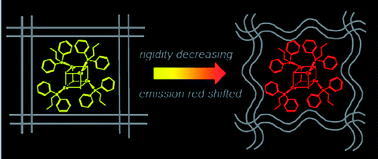Luminescence variation by rigidity control of acrylic composite materials†
Abstract
Photoluminescent composite materials whose emission depends on the rigidity of the hosting matrix were synthesized by dispersing molecular copper iodide clusters, [Cu4I4L4], in a series of photopolymerizable matrices exhibiting different glass transition temperatures (Tg). These matrices were obtained by blending at different molar ratios two chemically similar acrylic monomers presenting different flexibility. The kinetics of the photocuring process was followed by Real Time


 Please wait while we load your content...
Please wait while we load your content...